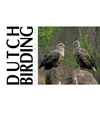Dutch Birding volume 29 (2007) no 4

Slender-Billed Gulls in the Netherlands in May 2006
On 5-9 May 2006, seven Slender-billed Gulls Larus genei were observed in three different areas in the Netherlands. In the evening of 5 May, three were photographed on a small IJsselmeer islet, De Kreupel, near Medemblik, Noord-Holland; due to restricted access and the presence of vulnerable breeding colonies, this news was released not earlier than two days later. One adult was present on the same islet during the morning of 6 May. Later that day, a pair (one subadult presumed female and an adult presumed male) was discovered along the IJsselmeer coast near Enkhuizen, Noord-Holland, a few km south-east of De Kreupel. They were twitched by many birders until they flew off across the IJsselmeer in the early evening. One of these two or, more likely, the third individual was then seen flying past twice before dark. Remarkably, at almost the same moment of the discovery near Enkhuizen, two were discovered at De Blikken near Groede, Zeeland, in the extreme south-west close to the Belgian border. Presumably, it concerned a pair of an adult wearing a green colour-ring on the right leg and a small metal ring on the left leg, and a possible second-summer, both staying until dark. In the evening of that very same day, two (subadult and adult) were found in the Dollard area, Groningen, in the extreme north-east close to the German border. The Dollard birds remained for several days and were last seen on 9 May. The two subadult birds were aged by the presence of small dark markings on the upperside of (some of) the tail-feathers, small dark markings on one of the tertials, paler orange-flesh (in stead of dark red) legs and a duller, more brownish coloured bill.
Elsewhere in Europe, the species was reported during early May 2006 in Austria (three), France (10 birds well away from breeding area), Germany (at least five), Norway (the first, if accepted) and Switzerland (at least seven). The first two for Belgium occurred at Het Zwin, West-Vlaanderen, on 9-11 May. One of the two wore a colour-ring showing that it was the same individual as one at Groede and, therefore, the second bird was assumed to be from Groede as well. The bird was ringed as pullus in a colony in Camargue, Bouches-du-Rhône, France, in July 2003 and was observed there also in August 2005 but, until May 2006, not anywhere else.
These seven birds were accepted by the Dutch rarities committee (CDNA) as the first for the Netherlands. There were two additional reports for May 2006: one of two birds briefly seen on 7 May and one of a first-summer watched for c 30 min on 17 May; both reports are still under consideration. Less than a year later, an adult was present at the Dutch/Belgian border of Het Zwin, Zeeland/West-Vlaanderen, on 12-13 April 2007. The ringed bird (together with two similar ringing records in Switzerland) indicates that at least some of these extralimital records originate from south-eastern France. The seasonal timing and the occurrence in pairs or small groups fit the pattern of vagrancy in north-western Europe.
Gert Ottens, Ganzebloem 14, 3984 CG Odijk, Nederland (glanskraai hotmail.com)
hotmail.com)
Jan-Pieter de Krijger, Weidemolen 98, 1622 KE Hoorn, Nederland (profparelhoen quicknet.nl)
quicknet.nl)
Eelke Schoppers, p/a Entinge 21, 9472 XJ Zuidlaren, Nederland (eelke.schoppers planet.nl)
planet.nl)
Bob Woets, Van Eckstraat 12, 1771 CM Wieringerwerf, Nederland (bobwoets quicknet.nl)
quicknet.nl)
Peter Lindenburg, Ronner Knipstraat 95, 2331 LX Leiden, Nederland (peter.lindenburg gmail.com)
gmail.com)
terug






